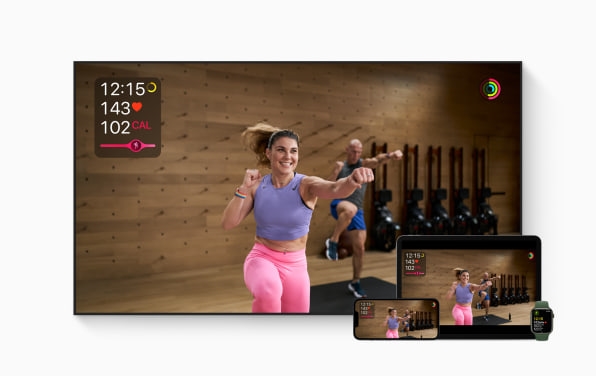Don’t look back, Peleton—Apple might be gaining on you
At its “California Streaming” product launch on Tuesday, Apple announced that members of its Fitness+ service will soon be able to work out together over SharePlay, a new Apple service that lets people co-stream videos on Apple devices. It felt like a direct strike at Peloton’s business, which—in addition to selling $1,495 stationary bikes and $2,495 treadmills—was making fitness social with digital classes even before the pandemic was underway. That made me wonder, would Apple take on Peloton even more directly by developing its own fitness equipment?
It wasn’t just Apple’s launch of Group Workouts that begged this question. It was also the new Fitness+ ad that the company showed during its event. In it, a variety of people work out in front of tablets and TVs, shiny Apple Watches clinging to their wrists. They are huffing and puffing in bedrooms, home offices, expansive marble-tiled living rooms, public outdoor basketball courts, gyms—the list goes on. “The club is the largest club in the world, because the club is the world,” a self-serious voice tells us, no gym membership needed.
But the enduring image from this nearly two-minute ad is that of a woman sitting on a stationary bicycle in front of her giant apartment windows about to take a Fitness+ class on her unbranded bike. It is reminiscent of all Peloton ads (including its most infamous) wherein an athletic, attractive woman peddles fervently in front of a window (who does this?). It seemed to suggest that Apple might be coming for Peloton’s clip-in shoes.
Could Apple make a fitness bike? Currently, Apple recommends a small list of third-party treadmills, rowing machines, and bikes for people who want to build out their home gym. None of this equipment has attached screens the way Peloton’s does. Instead it has a stand for smartphones or tablets.
To gather fitness stats, Apple Watch uses Apple’s GymKit technology to pair with certain equipment, such as Life Fitness cardio machines, so the Watch can get the most accurate workout data. But what if those machines could respond to health data? What if Apple built a bike that could tell you when you’re ready to level up to more intense exercises or down to recover based on your metrics?
“We love to integrate hardware, software, and services and find the intersection points of those because we think that’s where the magic occurs,” Apple CEO Tim Cook told Kara Swisher on her podcast, Sway. “And so that’s what we love to do. And we love to own the primary technology that’s around that.”
Apple has a history of starting with a software product and following up with the hardware. Most notably, it introduced its iTunes music software for Macs in January 2001, well before anyone had heard of the iPod. The company created the CarPlay in-dashboard infotainment system for cars in 2014 and is now (reportedly!) in the process of building a whole automobile. In this context, a bike or treadmill might seem like a logical follow-up to the ever-expanding Fitness+. Tom Cortese, one of Peloton’s founders, cites Apple directly as an inspiration, and early on Peloton was called the “Apple of fitness.” Doesn’t Apple want to be the Apple of fitness?

[Photo: Apple]
The answer is obviously yes. But Neil Cybart, Apple analyst and creator of Above Avalon, isn’t so sure the logical extension of Apple’s fitness ambitions is a bike or treadmill. “When you’re really into fitness—either endurance sports or running or cycling—you may think everyone is doing it, but the numbers are small relative to the overall population,” he says. “I think [Apple is] trying to go after people who maybe have never gone to a gym, and that addressable market is much larger.” He says he has a saying about this idea: Fitness is niche, health is mass market. Apple is going after overall health. “The battle is for the new users,” he says.
The vast majority of Americans own a car, which gives Apple a large market to go after. But even at the height of pandemic restrictions, only 5% of Americans were recommending a Peloton to family and friends, according to a YouGov survey. Plus, Cybart says, Apple is betting that the Apple Watch—which starts at just $199—is the more important fitness hardware to own.
In addition to fitness, Apple has also invested in health monitoring—going so far as to be able to integrate with patient electronic health records—through both the iPhone and the Watch. All together, this kind of health tracking could be more meaningful to someone who is just looking to be a little bit healthier.
The recent feature launches of Fitness+—pilates, low-impact cardio, and meditation classes—give credence to this idea. Group Workouts are part of that too, something that keeps people motivated to keep coming back to class. Cybart says he could see Apple adding personalized coaching to its roster of services.
Peloton may have to move in this direction as well. After massive sales during the pandemic, its stock is soft as growth has slowed. Despite selling 2.33 million Peloton devices, the company’s margins have shrunk. An easy way to grow could be to convince more users to pay for its class platform without any kind of corresponding equipment. Currently, 874,000 people subscribe to Peloton’s fitness app without a connected bike or treadmill. But here the company is now competing with Apple, which just expanded its global fitness footprint. Fitness+ will soon be available in 15 additional countries (Austria, Brazil, Colombia, France, Germany, Indonesia, Italy, Malaysia, Mexico, Portugal, Russia, Saudi Arabia, Spain, Switzerland, and the United Arab Emirates).
In Apple’s ad, our protagonist is humbler than Peloton’s boot camp warrior. Instead of a crop top, she wears an oversize mesh T-shirt. Accessibility is a dominant theme in Apple’s ad. Notably, one of the coaches uses sign language in their instruction. Another has a prosthetic leg. It is a much broader view of who works out—a different kind of aspirational.
(20)



